Wasp Repellent Paint: A Detailed Exploration
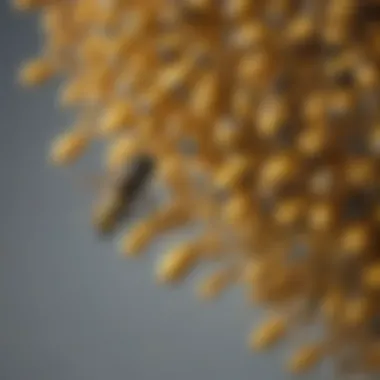
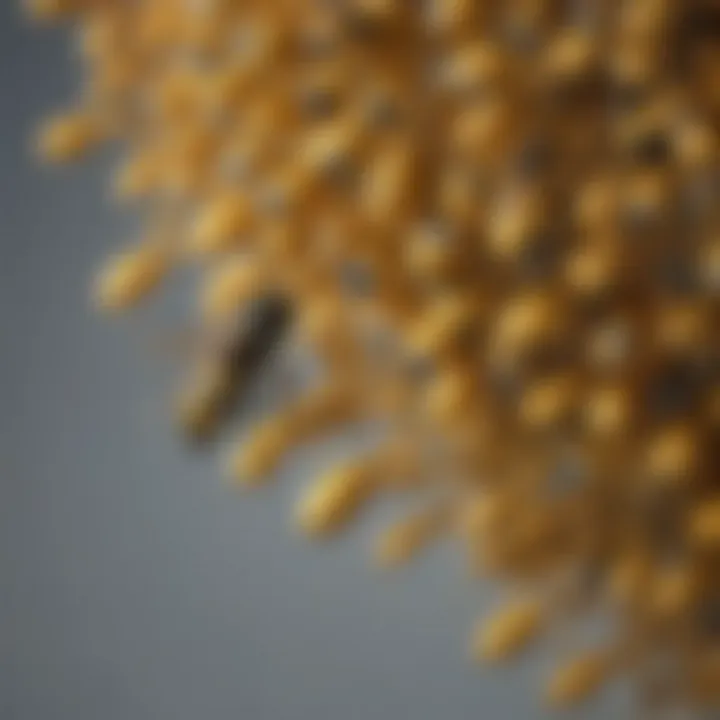
Intro
Wasp repellent paint is gaining traction as an innovative solution for those looking to safeguard their homes and businesses from unwanted wasp intrusions. Understanding the science behind it, along with its composition and practical applications, can significantly inform consumers about this versatile product. With a surge in awareness regarding environmentally friendly solutions, this paint not only aims to deter wasps but also to enhance aesthetics. It’s a fascinating mix of home improvement and pest control that bends traditional strategies to meet modern needs.
In this guide, we’ll peel back the layers on wasp repellent paint, exploring how it works, what it's made of, the range of its applications, and why it’s a remarkable option for both residential and commercial environments. Furthermore, we’ll touch upon the eco-friendly aspects that resonate with today’s increasingly conscious consumers, ensuring you gain a holistic view of this paint’s potential.
Design Inspirations
A home’s exterior not only needs to be functional but should also exude character. With wasp repellent paint, homeowners can achieve a level of design sophistication while keeping pests at bay.
Trending Styles
When considering wasp repellent paint, several styles resonate with today’s trends. For instance, matte finishes often lend a modern appearance that complements contemporary homes, whereas satin or gloss finishes can enhance a classic architectural style. Mixing textures and finishes can also create depth and interest that elegantly distracts from wasp traps or other prevention measures.
Color Palettes
Selecting the right colors is equally important. Natural hues like soft greens, earthy browns, and subtle grays not only blend seamlessly into the landscape but can also create a comforting atmosphere that feels inviting yet is unappealing to wasps. Bright colors like yellow or light blue, while attractive, should be carefully considered. While they might attract bees, the right shade might help deter wasps, striking the perfect balance between allure and repellency.
Maintenance and Upkeep
Once you’ve decided to enhance your space with wasp repellent paint, it’s crucial to keep proper upkeep in mind.
Seasonal Maintenance Checklist
- Inspect the Paint: After seasonal changes, check for chips or wear, particularly in high-traffic areas.
- Reapply as Necessary: Depending on the product, some paint lines require reapplication every few years to maintain efficacy.
- Monitor Surroundings: Keep an eye out for wasp nests nearby and evaluate your outdoor spaces for other potential attractants.
Cleaning and Organization Tips
Choosing eco-friendly cleaning products when caring for your painted surfaces will align with the paint's green vision. Regularly wiping down surfaces with a mild soap solution can help keep the color vibrant and maintain its protective features. Organizing outdoor spaces to reduce clutter can also discourage nesting, ensuring your wasp repellent paint serves its purpose effectively.
Implementing these practices not only prolongs the life of your paint but also contributes to creating an environment unsuitable for pests.
In summary, wasp repellent paint stands out as an exceptional innovation combining aesthetics with functionality. The removal of unwanted insects doesn't need to impact the beauty of your space, and through the right colors and designs, you can create a sanctuary that is both visually appealing and effectively protected. Keep your eyes peeled for the next advancements in this field, as the journey of enhancing living spaces continues!
Prologue to Wasp Repellent Paint
In the realm of pest management, wasp repellent paint has emerged as a innovative solution. This material promises to protect homes and businesses from the menace of wasp infestations while seamlessly blending into the design aesthetic of any environment. Understanding this concept becomes paramount for homeowners, interior designers, and even gardening enthusiasts who are looking for effective ways to deter these often-aggressive insects.
The aimportance of this topic extends beyond mere aesthetics; it offers a practical approach to pest control that aligns well with modern sensibilities toward safety and environmental consciousness. Here, we will explore its capabilities, benefits, and relevant considerations, laying the groundwork for a deeper understanding of how wasp repellent paint can enhance living spaces without compromising safety.
Defining Wasp Repellent Paint
Wasp repellent paint is a specialized coating designed to discourage wasp activity on treated surfaces. This paint is often formulated with certain chemicals or natural ingredients that interfere with a wasp's sensory perceptions, making environments less appealing to them. Essentially, it acts as a protective barrier through its unique properties, which can vary widely in formulation depending on the brand or intended use.
While the appearance might resemble standard wall paint, the true distinction lies in the chemical composition. One might say it's paint with a secret weapon; it does more than just add color. It potentially alters the way wasps perceive their surroundings, thus encouraging them to steer clear. For those who have ever endured the relentless annoyance of wasps flying too close for comfort, this repellent paint offers promising prospects.
Relevance in Modern Pest Management
The applications of wasp repellent paint are particularly relevant in today’s context of pest management. As more individuals seek non-toxic, environmentally friendly alternatives to conventional pest control methods, this innovation stands as a viable option. Traditional methods often come with sprays and traps that may pose harms to beneficial insects and the surrounding ecosystem.
With the use of wasp repellent paint, there is less risk involved. Homeowners can apply this solution to various surfaces—be it siding, fences, or outdoor furniture—without the heightened worry of collateral damage to helpful insects such as bees, which play a critical role in pollination.
Moreover, as outdoor living spaces expand in popularity, understanding the need to safeguard these areas has become more pertinent. People enjoy their gardens, patios, and porches, but enjoying these without the familiarity of annoying wasps buzzing about can be a game-changer. Integrating wasp repellant paint into the overall design and function of these spaces has not only aesthetic value but also aligns well with modern pest management practices, highlighting its relevance in today’s diverse pest-control conversation.
"Utilizing wasp repellent paint tidies up pest management in a way that feels almost intuitive for the user, making it a sensible choice."
By grasping these key components, we set the stage for deeper exploration into the elements that comprise wasp repellent paint, guiding homeowners and enthusiasts toward a more secure and appealing living environment.
Composition of Wasp Repellent Paint
Understanding the composition of wasp repellent paint is crucial for homeowners, designers, and those seeking effective pest control solutions. It sheds light on how the paint functions to deter wasps and prevents infestations without resorting to harsh chemicals or traditional methods. A well-formulated wasp repellent paint combines various ingredients that work in harmony, ensuring both effectiveness and safety in applications. Let's break down these elements to get a clearer picture of their roles and benefits.
Chemical Ingredients and Their Functions
A closer look at the chemical ingredients reveals a careful selection tailored for pest deterrence. Most wasp repellent paints typically include some variation of the following components:
- Active Repellents: These are the stars of the show. Ingredients like pepermint oil, citronella, or synthetic alternatives mimic natural deterrents. They confuse the sensory perception of wasps, making the painted areas less attractive.
- Binders: These play an essential role in ensuring that the paint adheres properly to surfaces. Acrylic or latex are common choices. They not only provide durability but also help release the active repellents gradually.
- Fillers and Extenders: Compounds like calcium carbonate add volume and improve texture. While they don't actively deter pests, they help in achieving the desired coverage and appearance.
- Solvents: To achieve the right consistency for application, solvents are needed. Water-based options are gaining popularity due to their eco-friendly nature, making them safer for homes and gardens.
Each ingredient serves a distinct purpose, contributing to the overall efficacy of the paint against wasps. The right combination enhances durability, aesthetic appeal, and, crucially, the deterrent action.
Natural Alternatives vs. Synthetic Options
In the realm of wasp repellent paint, choices abound—both natural and synthetic. Many homeowners are increasingly leaning toward natural alternatives due to concerns about chemicals and environmental impact.
- Natural Options: These often include essential oils, derived from plants. Oils like eucalyptus, lavender, and clove offer fragrant solutions that have shown effectiveness in repelling wasps. The added benefit of being eco-friendly makes them appealing for use near gardens or children's play areas.
- Synthetic Products: On the flip side, synthetic options, although sometimes seen as less desirable, can provide consistent results that natural ingredients may not always guarantee. They offer prolonged effectiveness and can be formulated to tackle more resistant wasp species or infestations.
Ultimately, the choice between natural and synthetic comes down to personal preference, environmental considerations, and specific pest control needs.
The composition of wasp repellent paint not only informs usability but also enhances the safety of surrounding environments—critical for conscientious homeowners.
Formulation Processes
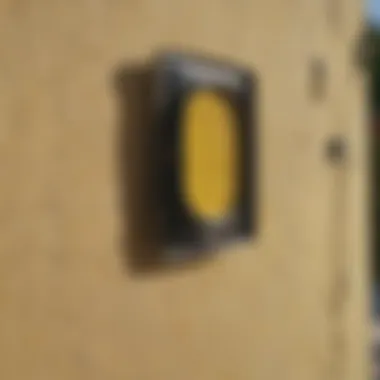
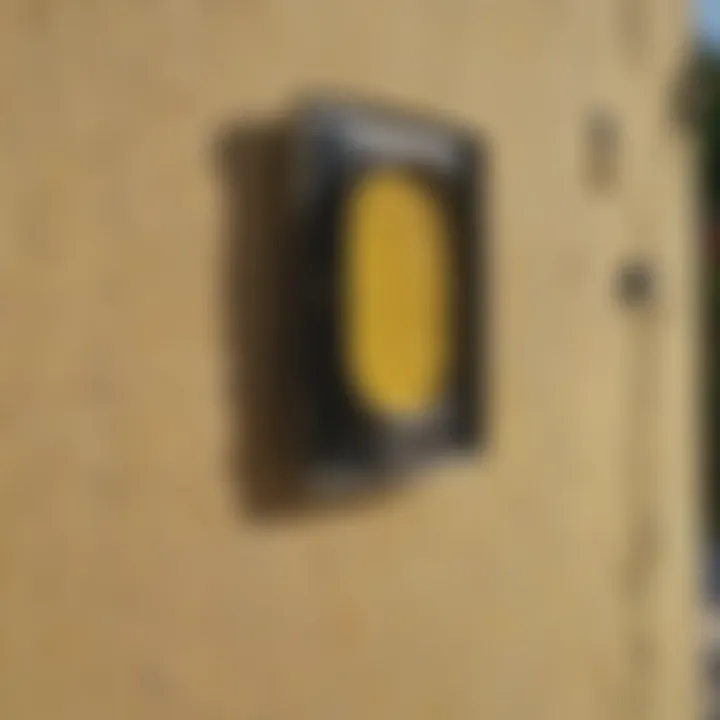
Formulation processes are the backbone of wasp repellent paint production. They involve a complex interplay of chemistry and engineering to ensure that the final product is effective, safe, and applicable for various surfaces. Understanding these processes is crucial for anyone interested in the efficacy and reliability of such paints. Quality and durability are top priorities in formulation, as is consistency—ensuring that each batch performs to the same high standard.
Manufacturing Techniques
The techniques used in manufacturing wasp repellent paint can have a dramatic impact on its performance. Among the most common methods are:
- Batch Processing: This traditional method allows for more control over the ingredients, making it easier to add specific repellents or enhance properties. Here, raw materials are mixed in defined quantities and processed in batches before being packaged.
- Continuous Processing: This technique pushes the mix through a series of machines, ensuring faster production under constant conditions. While it may lower costs and increase efficiency, it can sometimes compromise the unique properties of the paint, particularly if adjustments in formulation are necessary.
- Nanotechnology: Recent advances have opened doors to incorporating nanomaterials within wasp repellent paint. These minute particles can enhance adhesion and effectiveness, creating a stronger barrier against infestation. Not all manufacturers have embraced these innovations, but they do hold promise for improvements in efficiency and performance.
Each of these methods has its own pros and cons, depending on the desired outcome. Companies weigh factors like cost, time, and the specific application of the paint when deciding on the technique that suits their needs best.
Quality Control and Testing
Quality control is imperative throughout the entire manufacturing process to ensure that the wasp repellent paint is effective and safe. Here’s how it typically plays out in the industry:
- Raw Material Inspection: Before anything gets moving, suppliers undergo rigorous checks. Ingredients need to meet specific standards set by governing bodies. This step prevents subpar materials from entering production and affecting quality.
- In-Process Testing: During the mixing and formulation phases, consistent testing is performed. Parameters like viscosity, pH levels, and the ratio of active ingredients are monitored closely. This helps in maintaining the quality of each batch.
- Final Product Evaluation: Once production wraps up, the final product undergoes various tests to ensure its performance aligns with safety regulations. Paint samples are often subjected to laboratory experiments that replicate real-world conditions to analyze how well they repel wasps under different circumstances.
- Field Tests: After laboratory assessments, the paint may also be put through field tests. Trials conducted in controlled environments allow companies to gauge the paint’s resistance to weather, wear, and tear, ensuring it performs over a length of time.
"Quality assurance in the manufacturing of wasp repellent paint not only guarantees effectiveness but also ensures that it poses minimal risk to both users and the surrounding environment."
In sum, the processes involved in formulating wasp repellent paints are intricate and multifaceted. It’s not just about throwing ingredients together; it's an art and a science that ultimately dictates how well the paint will safeguard a property from those pesky wasps.
Effectiveness of Wasp Repellent Paint
Understanding the effectiveness of wasp repellent paint serves as a linchpin for anyone pondering its utility in maintaining a peaceful environment. Homeowners and business proprietors alike are constantly seeking feasible solutions to deter these vexatious insects. In this section, we will dissect the layers of effectiveness associated with wasp repellent paint, demonstrating its benefits while addressing relevant considerations that surround its application.
Scientific Studies and Findings
When it comes to wasp repellent paint, scientific examination provides us with solid ground to assert its effectiveness. Several researched pieces illustrate how particular ingredients in these paints interact with wasp physiology. One standout study, published in Entomological Society's journal, delves into how certain botanical oils, commonly present in wasp repellent compounds, disrupt the pheromone communication amongst wasps. When wasps can't communicate properly, their social structure weakens, leading them to abandon territorial claims.
Furthermore, lab trials have showcased that wasp repellent paints can reduce wasp landings by up to 75% in controlled environments. While the efficacy can vary based on factors like formulation and site conditions, these findings offer compelling proof of the paint's potential as a reliable deterrent against wasp infestations. Interestingly, these paints are designed to function effectively for a prolonged duration, meaning that once applied correctly, they continue to serve their purpose over time.
Comparative Analysis with Other Pest Control Methods
In the realm of pest control, various strategies vie for attention, but wasp repellent paint offers a unique angle. Comparing this paint with traditional methods such as traps, sprays, and chemical fumigants reveals both advantages and disadvantages. While traps can catch some wasps, they don't address the population at large. Sprays can be effective momentarily, but often they require frequent reapplication and pose risks of chemical exposure to humans and pets.
On the other hand, consider wasp repellent paint:
- Long-Lasting Defense: Once properly applied, it remains effective for months, even years, depending on weather conditions.
- Aesthetic Compatibility: Unlike unsightly traps that can be an eyesore, wasp repellent paint can blend seamlessly with a home’s or business's design, offering an unobtrusive solution.
- Eco-Friendliness: Many formulations are crafted using natural ingredients, minimizing environmental harm in contrast to conventional chemical methods.
While no single solution is foolproof, wasp repellent paint stands out as a practical and aesthetically pleasing alternative to more invasive interventions, making it worth considering for anyone troubled by these airborne nuisances. So, before reaching for that can of spray or setting traps, it's prudent to consider a more sustainable and stylish approach that not only protects your space but also complements its design.
"The paint doesn’t just seal walls; it seals out worries about wasps!"
Through a careful analysis of its steadfast efficacy and the depth of research backing its results, it is evident that wasp repellent paint holds considerable promise not just as a product but as part of a broader, more thoughtful strategy for pest management. Its comparative strengths in terms of longevity, aesthetics, and eco-friendliness position it as a frontrunner for discerning homeowners and design enthusiasts seeking lasting solutions against wasp intrusions.
Applications of Wasp Repellent Paint
Wasp repellent paint has emerged as an innovative solution to a problem that many homeowners and business owners face — the ever-growing threat of wasp infestations. This section focuses on the practical applications of this specialized paint, shedding light on its uses in both residential and commercial contexts. Understanding where and how to apply this product can be the key to taking control of wasp problems effectively.
Residential Uses
When it comes to residential spaces, the importance of wasp repellent paint cannot be overstated. For many families, the presence of wasps can create not just inconvenience but also safety concerns, especially for children and pets. Applying this type of paint can turn your home into a more welcoming sanctuary, away from the buzzing threats.
Benefits:
- Prevention at the Source: By painting areas where wasps tend to build nests, such as eaves, porch ceilings, or garden sheds, homeowners can significantly lower the chances of infestations.
- Aesthetic Appeal: Unlike traditional repellents, which may leave unsightly residue or odors, wasp repellent paint comes in various colors and finishes, allowing it to blend seamlessly with home design without compromising on function.
- Long-Term Solution: This paint is not just a temporary fix. Once applied correctly, it offers sustained protection, potentially saving homeowners money in the long run by reducing the need for frequent pest control services.
"The key to keeping your outdoor spaces enjoyable is to maintain them without the worry of unwanted visitors like wasps."
Commercial Applications
For businesses, maintaining a wasp-free environment is not only about comfort but also about safeguarding operations. Various commercial applications highlight how wasp repellent paint can be a part of pest management strategies in settings from restaurants to warehouses.
Considerations for Businesses:
- Food Safety: In outdoor dining settings, wasps can pose a direct threat to food safety. By implementing wasp repellent paint in areas such as patios and outdoor kitchens, businesses can create a safer dining experience.
- Enhanced Customer Experience: A wasp-free environment enhances the overall ambiance of commercial spaces, making it a pleasant destination for customers to work, shop, or dine. This can translate into repeat business and positive reviews.
- Compliance with Health Regulations: Certain businesses must comply with health and safety regulations that concerning pests. Utilizing wasp repellent paint can help in maintaining a pest-free zone, thereby ensuring compliance and avoiding hefty fines.
Examples of Commercial Uses:
- Restaurants: Exterior surfaces like decks and outdoor seating can benefit from a layer of protection.
- Warehouses: High ceilings and entry points exposed to outside environments are prime areas to apply this paint, helping minimize pest attractions around deliveries or stock areas.
- Event Venues: For venues hosting outdoor events, using wasp repellent paint not only protects guests but also safeguards the reputation of the venue instead of risking unwanted stings.
Best Practices for Application
When it comes to applying wasp repellent paint, getting it right can mean the difference between a pest-free environment and a challenging battle against unwelcome insects. This section dives into best practices for application, stressing the importance of doing things correctly from the beginning to maximize effectiveness and ensure longevity. Following these best practices not only enhances the performance of the paint but also provides long-term peace of mind for homeowners and businesses.
Surface Preparation Techniques
Before any painting begins, surface preparation is essential. Think of it as laying a solid foundation before building a home. If the surface isn’t adequately prepared, the paint may not adhere well, causing it to chip away and lose its protective qualities over time. Here are several key steps for preparing surfaces:
- Clean the Surface: Dust, dirt, and grease can hamper the paint's ability to bond. Use a power washer or a scraper to remove these contaminants. A clean surface ensures proper adhesion.
- Repair Damages: Examine the area for cracks or holes. Fill these with a suitable filler, allowing it to dry completely before moving on. Any untreated damage could lead to spots where wasps can enter once the paint has been applied.
- Sand the Surface: If the surface is glossy, light sanding may be necessary to create a texture that the paint can grip onto. This prepares the surface for a better bond.
- Prime if Necessary: For porous surfaces, applying a primer can help seal the material and provide a uniform base for the paint. This step can be especially crucial in areas that will experience high moisture.
Following these surface preparation techniques make an enormous difference in the effectiveness of wasp repellent paint. Taking the time to prepare properly leads to improved adhesion and longevity of the product.
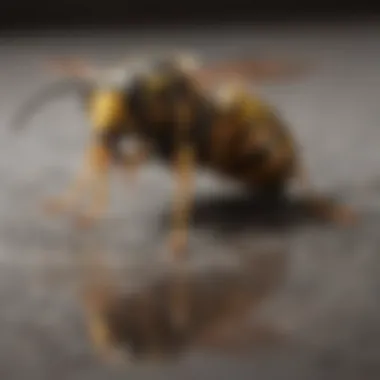
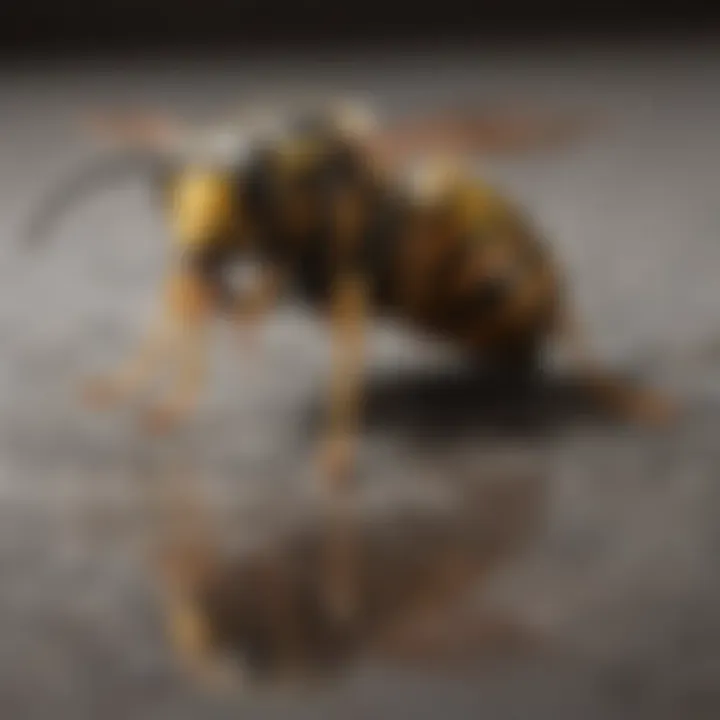
Application Methods for Optimal Results
Once the surface is prepped and primed, it’s time to turn to the application methods. Here are some practices to keep in mind to get the most out of wasp repellent paint:
- Choose the Right Tools: For large areas, consider using a sprayer, as it provides even coverage. However, for more detailed work, a brush or roller may give you more control.
- Follow Temperature Guidelines: Ensure that the temperature during application aligns with the manufacturer's recommendations. High humidity can lead to longer drying times, affecting the adhesion and overall effectiveness.
- Apply Evenly: This may seem obvious, but an even application ensures that the repellent properties are uniformly distributed. Avoid applying too thickly in any one coat; multiple thinner coats tend to bond better than one thick one.
- Respect Dry Time: Don’t rush the process. Allow each coat to dry according to the guidelines provided by the manufacturer. This increases the likelihood of the paint performing as intended.
By adhering to these guidelines, homeowners can ensure that their wasp repellent paint will perform optimally, creating an effective barrier against unwanted pests. It’s essential to remember that this is not just a cosmetic endeavor but a fundamental part of safe and sustainable pest management.
"Proper application techniques for wasp repellent paint can significantly improve the efficacy and lifespan of the product, making it a worthy investment." - Pest Control Expert
Potential Concerns and Misconceptions
When delving into wasp repellent paint, it’s crucial to address the potential concerns and misconceptions surrounding its use. Often, folks may dismiss this innovative solution due to various myths or misunderstandings. By shedding light on these issues, we can foster a clearer understanding of how this paint functions and its practical applications.
Understanding Limitations
Wasp repellent paint, while effective, does have its limitations. It's not a silver bullet for all wasp-related problems. For starters, this paint acts as a deterrent rather than a complete elimination method. Applying it does not guarantee that wasps won’t visit or establish a nest nearby. Factors such as location, weather, and the type of wasp can influence its effectiveness. Additionally, it may not work well on all surfaces. Rough, uneven surfaces may not hold the repellent properties effectively, reducing the paint's efficacy. Different species of wasps also react differently; some may be more tenacious, ignoring the paint altogether.
For homeowners linking their worries about safety with wasp infestations, it's important to remember that while the paint can discourage these pests, it should be part of a larger integrated pest management strategy. Regular inspections and maintenance are vital for long-term efficacy.
Debunking Common Myths
Several myths surround the use of wasp repellent paint that can mislead consumers. One prevalent misconception is that the paint is toxic or harmful to wasps or other beneficial insects. Contrary to this belief, many wasp repellent paints are formulated with natural ingredients designed to create an unwelcoming environment without endangering non-target species. Their aim is to provide discomfort to the wasps, not harm.
Another myth suggests that once applied, the paint can offer permanent protection against wasps. In reality, environmental factors can diminish the effectiveness of the paint over time. Rain, UV exposure, and general wear and tear can gradually weaken the paint’s deterrent properties. It's essential to treat wasp repellent paint not as a one-time solution but as a component of ongoing pest management.
Lastly, there's a belief that decorative qualities are sacrificed when choosing such paint. Today’s formulations are designed to seamlessly blend with various design aesthetics. Homeowners can achieve both functionality and aesthetic appeal, ensuring that their spaces remain attractive while also reducing the chances of unwanted insect visitors.
"Wasp repellent paint should be seen as one tool among many in the fight against unwanted pests, not the only tool in your arsenal."
Environmental Considerations
When discussing wasp repellent paint, it's critical to consider the wider environmental implications. This topic isn't just about keeping pests at bay; it's about ensuring that our homes and surroundings maintain harmony with the ecosystems they inhabit. The ramifications of pest control methods extend beyond human comfort. As we delve into this subject, it highlights the necessity of eco-friendly choices that benefit both us and the planet.
Impact on Ecosystems
Wasp repellent paint interacts uniquely with the environment. While these paints aim to deter specific pests, it's essential to evaluate whether they might inadvertently affect beneficial insects. Wasps, for instance, play critical roles in pollination and controlling pest populations. Thus, any repellent formulation must be designed to target specific species while minimizing the disruption to surrounding wildlife.
A careful selection of ingredients can significantly lessen the ecological footprint. Paints that rely on natural deterrents, for example, offer alternatives that are less likely to harm non-target species. Long-term, a healthy ecosystem can flourish when wasps and other insects aren't indiscriminately eliminated. With this in mind, testing and evaluating the environmental impact of these paints become toughy associated with ensuring they do not wreak havoc on local biodiversity.
"It's not just about securing your space; it's about preserving the balance of nature around you."
Aligning with Sustainable Practices
Adopting wasp repellent paint can resonate strongly with sustainable practices, especially when considering the growing consumer awareness regarding eco-friendliness. Homeowners and businesses alike find themselves increasingly drawn to products that reflect environmental responsibility. Wasp repellent paints, notably those made with sustainable materials, allow consumers to protect their spaces while staying committed to Earth-friendly practices.
Incorporating sustainable practices means encouraging manufacturers to develop innovative formulations. This transformation could lead to:
- Reduction in harmful chemicals: The shift from synthetic to more natural ingredients not only caters to safety but also ensures a healthier environment.
- Recyclable packaging: Sustainable brands often focus on reducing waste, offering recyclable options or biodegradable packaging methods.
- Responsible sourcing: Utilizing materials sourced from renewable resources engages a cycle of sustainability that promotes ecological balance.
Understanding these factors can set the stage for a broader movement towards eco-conscious living. Individuals playing their part in this change contribute to collective effort, supporting brands that prioritize the planet as much as they do pest control.
Future Trends in Wasp Deterrent Technologies
Understanding the future trends in wasp deterrent technologies is crucial for anyone looking to protect their spaces effectively. As pest control methods evolve, so too does the science behind wasp repellent paint. Homeowners, garden lovers, and even business owners need to keep an eye on these developments. It can save not just time and money, but also a lot of headaches when it comes to dealing with pesky wasps.
Emerging Technologies in Pest Control
Today’s pest control landscape is shifting more towards advanced and innovative technologies. They bring with them enhanced effectiveness against wasp infestations. Here are a few noteworthy trends that stand out:
- Smart Sensors: New types of systems are being developed. They can monitor wasp activity in real time. These sensors help detect nests before they become a serious issue. Knowing where the wasps are can allow homeowners to act fast without causing unnecessary chemical exposure.
- Biodegradable Solutions: There’s a growing focus on using more eco-friendly materials to deter pests. Paint that incorporates natural repelling agents is gaining traction. These solutions are not just safer for the environment, but they often show good effectiveness as well.
"The integration of technology in pest control signifies a substantial leap forward, providing solutions that are both effective and sustainable."
- Drones for Material Distribution: Intriguingly, some companies are looking into drone technology for applying wasp repellent paint in hard-to-reach areas. It's an innovative way to cover spaces that are usually tricky without human intervention.
Through these emerging technologies, the pest control industry aims to provide methods that are not only strategic but also nuanced in their approach. This means individuals can enjoy their outdoor spaces without the constant worry of wasp invasions.
Innovations on the Horizon
As we peek into the future, several innovative ideas are poised to transform the realm of wasp control:
- Smart Paints with Active Ingredients: One exciting concept is the development of paint that can change its properties based on environmental factors. For example, a paint that reacts to humidity, becoming more potent against wasps when it’s warm and humid.
- AI-Driven Solutions: Artificial intelligence is making waves in many industries. Soon, it may infiltrate pest control too. AI could be used to analyze data from previous infestations and predict potential outbreaks, thus allowing for preemptive action.
- Combining Techniques: Rather than relying solely on repellent paint, experts may find success in blending traditional pest control with modern tech approaches. This could include integrating pheromone traps with painted surfaces to create an ecosystem of deterrence.
The combination of these innovation and technologies hints at a future where pest control is not just reactive but proactive. This could change the game for many, helping them enjoy their backyards, gardens, and public spaces without the fear of wasps.
As trends continue to evolve, there’s no doubt that the landscape of wasp deterrents will see significant change. Staying informed is not just beneficial—it's essential.
Cost-Effectiveness of Wasp Repellent Paint
Understanding the cost-effectiveness of wasp repellent paint is crucial for homeowners and business owners who often find themselves battling uninvited wasp guests. The use of such paint can represent a strategically sound investment, reducing the dependency on traditional pest control methods like sprays or traps, which may provide a temporary fix rather than a long-term solution. Here, we take a look at various aspects that underscore the value of this innovative product.
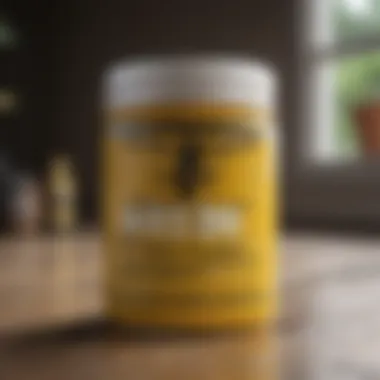

Evaluating Long-Term Value
When discussing long-term value, it's essential to analyze both the economic and psychological aspects of wasp repellent paint.
- Durability: Most wasp repellent paint formulations are designed to last for several years, making it a cost-saving alternative over time. As a one-time application might serve multiple seasons, the need for frequent replacements is eliminated, which can translate to savings in both materials and labor.
- Insurance: The costs associated with wasp infestations go beyond the mere inconvenience of removal. Insurance claims due to property damage can add up. Investing in wasp repellent paint not only protects physical structures but also potentially shields homeowners from claims involving damages caused by these pests.
- Discomfort and Anxiety: Beyond financial aspects, wasps can instill anxiety in social settings. Knowing that your outdoor areas are protected can lead to a more pleasurable experience for gatherings. This peace of mind is a value that’s hard to quantify.
"The longer you can avoid a problem, the more money you can save."
Cost Comparison with Alternative Solutions
Evaluating the cost of wasp repellent paint against traditional pest control methods reveals important insights.
- Spray Treatments: These often require periodic applications, usually ranging from $30 to $100 per treatment, depending on the coverage area and infestation level. Over a year, this can add up significantly, especially during peak wasp season.
- Traps and Baits: Purchasing traps can be a cheaper initial investment, but the effectiveness is sporadic. You might end up spending about $20 to $50 on reusable traps which still require regular maintenance and might not yield the desired long-term control.
- Professional Extermination Services: Typically, hiring an exterminator can cost upwards of $200 per visit. This can escalate, especially if the infestation isn't dealt with properly in the first go.
In contrast, a gallon of wasp repellent paint could cost around $70 to $150 and would generally cover a larger area. As such, the upfront cost might initially seem heavier, but when you add up the long-term savings from reduced treatments and repairs, it often comes out as a prudent choice for many homeowners.
Utilizing wasp repellent paint is not just about keeping those pesky critters at bay; it’s also about wise spending, ensuring safety and comfort in your own space.
User Testimonials and Case Studies
User testimonials and case studies play a crucial role in understanding the real-world application and efficacy of wasp repellent paint. While scientific studies provide a controlled environment to gauge effectiveness, firsthand accounts and documented experiences give a more personalized view of how such products perform in everyday scenarios. Homeowners, particularly those living in areas with high wasp activity, often seek reliable, tried-and-true solutions. It’s not just about how the paint is made; it’s about how it stands the test of time and results in fewer unpleasant encounters with buzzing pests.
In the vast landscape of home improvement solutions, peer feedback provides invaluable insights often overlooked. For example, individuals might share their experiences with durability, ease of application, and, most importantly, how well the paint kept wasps at bay across seasons. This kind of information is crucial—not only for homeowner confidence but also for any professional landscape designers or pest control experts looking to recommend products to clients.
Considerations about user feedback can range from the paint’s longevity on different surfaces to its resistance to harsh weather. Real-life case studies often highlight scenarios where similar products fell short and contrast these to successes with wasp repellent paints. Understanding why a certain kind of paint worked effectively in a community setting can lead to better recommendations in a broader context.
"After applying the wasp repellent paint to our porch, we noticed a significant drop in wasp presence. We can finally enjoy our outdoor space without worrying about the occasional sting!" — Sarah T., satisfied homeowner.
Real-Life Experiences
The value of personal experiences cannot be understated when discussing the practicality of wasp repellent paint. Many homeowners report dramatic shifts in their outdoor comfort levels after application. For instance, one couple recounted their struggle at their backyard barbecue gatherings, where wasps would inevitably crash the party, causing distress among guests, especially children.
After applying a highly recommended wasp repellent paint, their next outdoor event met with much applause and minimal disruption from pests. They've reported that the paint not only provided visual appeal but also blanketed their space with a protective layer that effectively deterred the insects.
Examples like these illustrate that satisfaction varies by user experience but can create a consensus on the quality of a product. In a localized community, positive feedback can quickly become a word-of-mouth advertisement, encouraging others to try the product. Additionally, these experiences lead to discussions on optimal application techniques and any necessary pre-application steps that are not widely publicized.
Insights from Professionals
Insights from professionals in pest control and interior design enrich the narrative surrounding wasp repellent paint immensely. Experts often provide a more in-depth look into why some paints work better than others, based on their formulations. Pest control specialists frequently evaluate paint products both for effectiveness and for their overall health and safety measures, particularly considering indoor environments.
For instance, a pest control technician noted that while some paints claim to repel wasps, the science behind the active ingredients is what truly dictates performance. This level of scrutiny helps consumers make informed decisions. Also, professional painters have chimed in on the techniques they recommend for application, ensuring clients achieve maximum protection.
This interplay between user testimonials and professionals' expert opinions creates a robust understanding of the product. Homeowners can navigate their purchasing decisions knowing they have the backing of both their community and trusted experts. With this dual lens—real-life experiences coupled with professional insights—the effectiveness and reliability of wasp repellent paint become clearer and far more compelling.
Incorporating Wasp Repellent Paint in Design Aesthetics
Incorporating wasp repellent paint extends far beyond the simple act of applying a protective layer against nuisances. It encapsulates the art of harmonizing functionality with aesthetic beauty, allowing homeowners and designers to tread the fine line between style and safety. As we explore this necessity, it becomes evident that understanding the integration of wasp repellent paint into design is pivotal not just for pest control, but for enhancing the overall appeal of spaces.
Compatibility with Interior Design
When it comes to interior spaces, compatibility between paint and design style is key. Wasp repellent paint offers versatility in colors that can easily blend into various schemes, whether you’re opting for a sleek modern look, a cozy rustic vibe, or something more eclectic. For instance, a soft pastel hue can warm up a space and create an inviting atmosphere, while a bold, darker shade might lend a touch of sophistication.
Furthermore, many manufacturers now produce wasp repellent paint that features a matte or satin finish, which can align perfectly with current design trends. Interior designers are finding innovative ways to incorporate these coatings, often using them to create accent walls that not only ward off pests but also serve as focal points within a room.
- Texture Matters: Depending on the finish, textural effects can enhance depth. This aspect plays a crucial role in how light interacts with the surface, creating shadows that can add character to a room.
- Functional Art: Wall murals and graphics can be executed in wasp repellent paint, transforming potential pest havens into stunning visual canvases.
Exterior Applications that Enhance Curb Appeal
For the exterior, the stakes are higher since curb appeal significantly influences property values. Wasp repellent paint helps to ensure that a house stands out while being safeguarded against pests. Homeowners are increasingly aware that the outward appearance of their residence is often their first impression to guests and passersby, thus choices made here matter immensely.
Using wasp repellent paint on exterior surfaces such as siding, porches, or garden furniture opens up a world of possibilities:
- Color Choices and Finishes: Just like interiors, exteriors offer various shades. Bright colors can draw attention and evoke a sense of happiness. Subtle tones can provide an elegant yet understated look, fitting nicely into the surrounding landscape.
- Patterns and Designs: For exterior applications, there's room to play with patterns. Stencils or artistic designs can be used to create unique looks, contributing both to beauty and functionality.
Choosing the right type of paint could also bolster durability against weather conditions while providing that wasp-repelling benefit. With clever planning and the right application methods, wasp repellent paint can not only protect but also enhance the allure of a property, making it a win-win decision for discerning homeowners.
Key Insight: The perfect blend of aesthetic appeal and practical protection ensures that spaces are both beautiful and safe, allowing homeowners to enjoy their surroundings to the fullest.
The End and Future Perspectives
As we wrap up our exploration of wasp repellent paint, it's clear that this innovative product holds significant potential for homeowners and professionals alike. Wasp repellent paint not only enhances aesthetics but also serves a practical purpose in maintaining comfort and safety in our living and working environments. By effectively deterring wasps, this paint can help minimize uninvited guests at garden parties or reduce the risk of stings during outdoor activities.
Summarizing Key Takeaways
Here’s what we can take home from our deep dive into wasp repellent paint:
- Dual Functionality: These paints don’t just refresh a space; they act as a barrier against wasp invasions, which is vital for maintaining a pleasant atmosphere, especially in outdoor settings.
- Variety in Composition: The range of formulas available—from natural options to synthetic solutions—provides flexibility for users looking for specific benefits, including eco-friendliness or longer-lasting protection.
- Application Techniques Matter: Proper surface preparation and application methods can significantly impact the effectiveness of these paints. Awareness of these details can enhance their performance and lifespan.
- Ongoing Research and Development: The advancements in wasp repellent technologies promise even more effective solutions, potentially reducing reliance on traditional pest control methods.
Each of these points resonates with the overarching theme of this article: enhancing our spaces can also involve safeguarding them.
The Importance of Continued Research
We stand on the brink of exciting developments in pest management strategies. The significance of continued research in the realm of wasp deterrent technologies cannot be overstated.
- Understanding Effectiveness: More studies are needed to scientifically validate the long-term effectiveness of wasp repellent paint across various environments and conditions.
- Exploring New Formulations: Innovations in chemistry might lead to the discovery of new compounds that could be used in wasp repellent paint, providing even better deterrents without harming the environment.
- Public Awareness and Education: Ongoing research can shape how people perceive pest management technologies. As more information becomes available, consumers will make better-informed choices about their pest control methods.
In essence, the future of wasp management hinges on sustained inquiry and innovation. Embracing these advancements will not only bolster the effectiveness of unusual yet remarkable pest solutions but also cater to the eco-friendly preferences of today’s conscientious homeowners.







